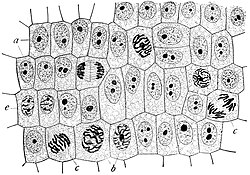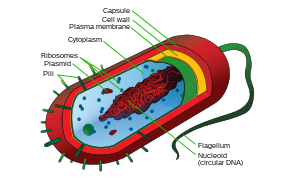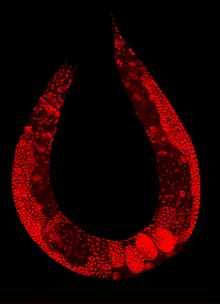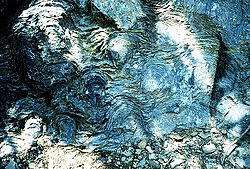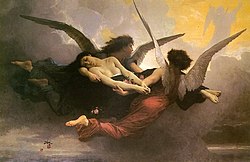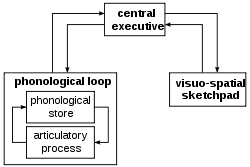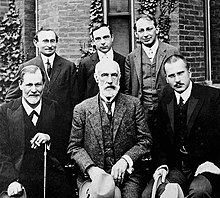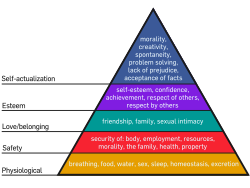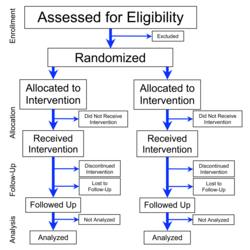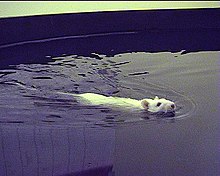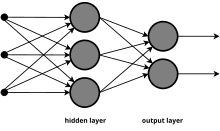|
|
| [hide]This article has multiple issues. Please help improve it or discuss these issues on the talk page. |
| This article needs additional citations for verification. (December 2014) |
|
|
The soul, in many religious, philosophical and mythological traditions, is the incorporeal and, in many conceptions,immortal essence of a living thing.[1] According to most of the Abrahamic religions, immortal souls belong only to human beings. For example, the Catholic theologian Thomas Aquinas attributed “soul” (anima) to all organisms but argued that only human souls are immortal.[2] Other religions (most notably Jainism and Hinduism) teach that all biological organisms have souls, and others teach that even non-biological entities (such as rivers and mountains) possess souls. This latter belief is called animism.[3]
Greek philosophers such as Socrates, Plato and Aristotle understood the psyche (ψυχή) to be crowned with the logical faculty, the exercise of which was the most divine of human actions. At his defense trial, Socrates even summarized his teachings as nothing other than an exhortation for his fellow Athenians to excel in matters of the psyche since all bodily goods are dependent on such excellence (The Apology 30a–b).
Anima mundi is the concept of a “world soul” connecting all living organisms on the planet.
Linguistic aspects[edit]
Etymology[edit]
The Modern English word “soul“, derived from Old English sáwol, sáwel, was first attested to in the 8th-century poemBeowulf v. 2820 and in the Vespasian Psalter 77.50—it is cognate with other Germanic and Baltic terms for the same idea, including Gothic saiwala, Old High German sêula, sêla, Old Saxon sêola, Old Low Franconian sêla, sîla, Old Norse sála andLithuanian siela. Further etymology of the Germanic word is uncertain. The original concept is said to mean originally ‘coming from or belonging to the sea/lake’ because of the Germanic belief in souls being born out of and returning to sacred lakes, c.f., Old Saxon sêola (soul) compared to Old Saxon sêo (sea).
The Koine Greek word ψυχή psychē, “life, spirit, consciousness”, is derived from a verb meaning “to cool, to blow”, and hence refers to the breath, as opposed to σῶμα (“soma”), meaning “body”. Psychē occurs juxtaposed to σῶμα, as seen inMatthew 10:28:
- — καὶ μὴ φοβεῖσθε ἀπὸ τῶν ἀποκτεννόντων τὸ σῶμα, τὴν δὲ ψυχὴν μὴ δυναμένων ἀποκτεῖναι·
φοβεῖσθε δὲ μᾶλλον τὸν δυνάμενον καὶ ψυχὴν καὶ σῶμα ἀπολέσαι ἐν γεέννῃ.
- Vulgate: et nolite timere eos qui occidunt corpus animam autem non possunt occidere sed potius eum timete qui potest et animam et corpus perdere in gehennam.
- Authorized King James Version (KJV) “And fear not them which kill the body, but are not able to kill the soul: but rather fear Him which is able to destroy both soul and body in hell.”
In the Septuagint (LXX), ψυχή translates Hebrew נפש nephesh, meaning “life, vital breath”, and specifically refers to a mortal, physical life, but is in English variously translated as “soul, self, life, creature, person, appetite, mind, living being, desire, emotion, passion”; an example can be found in Genesis 1:20:
- — וַיֹּ֣אמֶר אֱלֹהִ֔ים יִשְׁרְצ֣וּ הַמַּ֔יִם שֶׁ֖רֶץ נֶ֣פֶשׁ חַיָּ֑ה
- LXX καὶ ἐποίησεν ὁ θεὸς τὰ κήτη τὰ μεγάλα καὶ πᾶσαν ψυχὴν ζῴων ἑρπετῶν.
- Vulgate Creavitque Deus cete grandia, et omnem animam viventem atque motabilem.
- KJV “And God created great whales, and every living creature that moveth.”
Paul of Tarsus used ψυχή and πνεῦμα specifically to distinguish between the Jewish notions of נפש nephesh and רוח ruah(spirit) (also in LXX, e.g. Genesis 1:2 וְר֣וּחַאֱלֹהִ֔ים = πνεῦμα θεοῦ = spiritus Dei = “the Spirit of God”).[citation needed]
Philosophical views[edit]
The Ancient Greeks used the word for “alive” to also apply to the concept of being “ensouled“, indicating that the earliest surviving western philosophical view believed that the soul was that which gave the body life. The soul was considered the incorporeal or spiritual “breath” that animates (from the Latin, anima, cf. “animal”) the living organism.[citation needed]
Francis M. Cornford quotes Pindar by saying that the soul sleeps while the limbs are active, but when one is sleeping, the soul is active and reveals “an award of joy or sorrow drawing near”in dreams.[4]
Erwin Rohde writes that an early pre-Pythagorean belief presented the soul as lifeless when it departed the body, and that it retired into Hades with no hope of returning to a body.[5]
Socrates and Plato[edit]
Drawing on the words of his teacher Socrates, Plato considered the psyche to be theessence of a person, being that which decides how we behave. He considered this essence to be an incorporeal, eternal occupant of our being. Socrates says that even after death, the soul exists and is able to think. He believed that as bodies die, the soul is continually reborn in subsequent bodies and Plato believed this as well; however, he thought that only one part of the soul was immortal (logos). The Platonic soul consists of three parts:
- the logos, or logistikon (mind, nous, or reason)
- the thymos, or thumetikon (emotion, spiritedness, or masculine)
- the eros, or epithumetikon (appetitive, desire, or feminine)
The parts are located in different regions of the body:
- logos is located in the head, is related to reason and regulates the other part.
- thymos is located near the chest region and is related to anger.
- eros is located in the stomach and is related to one’s desires.
Plato also compares the three parts of the soul or psyche to a societal caste system. According to Plato’s theory, the three-part soul is essentially the same thing as a state’s class system because, to function well, each part must contribute so that the whole functions well. Logos keeps the other functions of the soul regulated.
Aristotle[edit]
Aristotle (384 BC – 322 BC) defined the soul, or Psūchê (ψυχή), as the “first actuality” of a naturally organized body,[6] and argued against its separate existence from the physical body. In Aristotle’s view, the primary activity, or full actualization, of a living thing constitutes its soul. For example, the full actualization of an eye, as an independent organism, is seeing (its purpose or final cause).[7] Another example is that the full actualization of a human being would be living a fully functional human life in accordance with reason (which he considered to be a faculty unique to humanity).[8] For Aristotle, the soul is the organization of the form and matter of a natural being which allows it to strive for its full actualization. This organization between form and matter is necessary for any activity, or functionality, to be possible in a natural being. Using an artifact (non-natural being) as an example, a house is a building for human habituation, but for a house to be actualized requires the material (wood, nails, bricks, etc.) necessary for its actuality (i.e. being a fully functional house). However, this does not imply that a house has a soul. In regards to artifacts, the source of motion that is required for their full actualization is outside of themselves (for example, a builder builds a house). In natural beings, this source of motion is contained within the being itself.[9] Aristotle elaborates on this point when he addresses the faculties of the soul.
The various faculties of the soul, such as nutrition (also known as vegetative (peculiar to plants)); movement (also known as passionate (peculiar to animals)); reason (peculiar to humans); sensation (special, common, and incidental); and so forth, when exercised, constitute the “second” actuality, or fulfillment, of the capacity to be alive.[citation needed] For example, someone who falls asleep, as opposed to someone who falls dead, can wake up and go about their life, while the latter can no longer do so.
Aristotle identified three hierarchical levels of natural beings: plants, animals, and people. For these groups, he identified three corresponding levels of soul, or biological activity: the nutritive activity of growth, sustenance and reproduction which all life shares; the self-willed motive activity and sensory faculties, which only animals and people have in common; and finally “reason”, of which people alone are capable.
Aristotle’s discussion of the soul is in his work, De Anima (On the Soul). Although mostly seen as opposing Plato in regard to the immortality of the soul, a controversy arose in relation to the fifth chapter of the third book. In this text, both interpretations can be argued for: soul as a whole is mortal, or a part called “active intellect” or “active mind” is immortal and eternal.[10] Commentators exist on both sides of the controversy, but it is understood that there will be permanent disagreement about its final conclusions, as no other Aristotelian text contains this specific point, and this part of De Animais obscure.[11]
Avicenna and Ibn al-Nafis[edit]
Following Aristotle, Avicenna (Ibn Sina) and Ibn al-Nafis, a Persian philosopher, further elaborated upon the Aristotelian understanding of the soul and developed their own theories on the soul. They both made a distinction between the soul and the spirit, and the Avicennian doctrine on the nature of the soul was influential among the Scholastics. Some of Avicenna’s views on the soul include the idea that the immortality of the soul is a consequence of its nature, and not a purpose for it to fulfill. In his theory of “The Ten Intellects”, he viewed the human soul as the tenth and final intellect.
While he was imprisoned, Avicenna wrote his famous “Floating Man” thought experiment to demonstrate human self-awareness and the substantial nature of the soul. He told his readers to imagine themselves suspended in the air, isolated from all sensations, which includes no sensory contact with even their own bodies. He argues that in this scenario one would still have self-consciousness. He thus concludes that the idea of the self is not logically dependent on any physicalthing, and that the soul should not be seen in relative terms, but as a primary given, a substance. This argument was later refined and simplified by René Descartes in epistemic terms, when he stated: “I can abstract from the supposition of all external things, but not from the supposition of my own consciousness.”[12]
Avicenna generally supported Aristotle’s idea of the soul originating from the heart, whereas Ibn al-Nafis rejected this idea and instead argued that the soul “is related to the entirety and not to one or a few organs“. He further criticized Aristotle’s idea whereby every unique soul requires the existence of a unique source, in this case the heart. al-Nafis concluded that “the soul is related primarily neither to the spirit nor to any organ, but rather to the entire matter whose temperament is prepared to receive that soul,” and he defined the soul as nothing other than “what a human indicates by saying “I“.[13]
Thomas Aquinas[edit]
Following Aristotle and Avicenna, Thomas Aquinas (1225–74) understood the soul to be the first actuality of the living body. Consequent to this, he distinguished three orders of life: plants, which feed and grow; animals, which add sensation to the operations of plants; and humans, which add intellect to the operations of animals.[citation needed]
Concerning the human soul, his epistemological theory required that, since the knower becomes what he knows, the soul is definitely not corporeal—if it is corporeal when it knows what some corporeal thing is, that thing would come to be within it.[14] Therefore, the soul has an operation which does not rely on a bodily organ, and therefore the soul could subsist without a body. Furthermore, since the rational soul of human beings is a subsistent form and not something made of matter and form, it cannot be destroyed in any natural process.[15] The full argument for the immortality of the soul and Aquinas’ elaboration of Aristotelian theory is found in Question 75 of the Summa Theologica.
Immanuel Kant[edit]
In his discussions of rational psychology, Immanuel Kant (1724–1804) identified the soul as the “I” in the strictest sense, and that the existence of inner experience can neither be proved nor disproved. “We cannot prove a priori the immateriality of the soul, but rather only so much: that all properties and actions of the soul cannot be cognized from materiality”. It is from the “I”, or soul, that Kant proposes transcendental rationalization, but cautions that such rationalization can only determine the limits of knowledge if it is to remain practical.[16]
Philosophy of mind[edit]
Gilbert Ryle‘s ghost-in-the-machine argument, which is a rejection of Descartes’ mind-body dualism, can provide a contemporary understanding of the soul/mind, and the problem concerning its connection to the brain/body.[17]
Religious views[edit]
Ancient Near East[edit]

The souls of Pe andNekhen towing the royal bargue on a relief ofRamesses II‘s temple in Abydos.
In the ancient Egyptian religion, an individual was believed to be made up of various elements, some physical and some spiritual.
Similar ideas are found in ancient Assyrian and Babylonian religion. Kuttamuwa, an 8th-century BC royal official from Sam’al, ordered an inscribed stele erected upon his death. The inscription requested that his mourners commemorate his life and his afterlife with feasts “for my soul that is in this stele”. It is one of the earliest references to a soul as a separate entity from the body. The 800-pound (360 kg) basalt stele is 3 ft (0.91 m) tall and 2 ft (0.61 m) wide. It was uncovered in the third season of excavations by the Neubauer Expedition of the Oriental Institute in Chicago, Illinois.[18]
The Bahá’í Faith affirms that “the soul is a sign of God, a heavenly gem whose reality the most learned of men hath failed to grasp, and whose mystery no mind, however acute, can ever hope to unravel”.[19] Bahá’u’lláh stated that the soul not only continues to live after the physical death of the human body, but is, in fact, immortal.[20] Heaven can be seen partly as the soul’s state of nearness to God; and hell as a state of remoteness from God. Each state follows as a natural consequence of individual efforts, or the lack thereof, to develop spiritually.[21] Bahá’u’lláh taught that individuals have no existence prior to their life here on earth and the soul’s evolution is always towards God and away from the material world.[21]
Buddhism[edit]
Buddhism teaches that all things are in a constant state of flux: all is changing, and no permanent state exists by itself.[22][23]This applies to human beings as much as to anything else in the cosmos. Thus, a human being has no permanent self.[24][25] According to this doctrine of anatta (Pāli; Sanskrit: anātman) – “no-self” or “no soul” – the words “I” or “me” do not refer to any fixed thing. They are simply convenient terms that allow us to refer to an ever-changing entity.[26]
The anatta doctrine is not a kind of materialism. Buddhism does not deny the existence of “immaterial” entities, and it (at least traditionally) distinguishes bodily states from mental states.[27] Thus, the conventional translation of anatta as “no-soul”[28] can be confusing. If the word “soul” simply refers to an incorporeal component in living things that can continue after death, then Buddhism does not deny the existence of the soul.[29] Instead, Buddhism denies the existence of a permanent entity that remains constant behind the changing corporeal and incorporeal components of a living being. Just as the body changes from moment to moment, so thoughts come and go. And there is no permanent, underlying mind that experiences these thoughts, as in Cartesianism; rather, conscious mental states simply arise and perish with no “thinker” behind them.[30] When the body dies, Buddhists believe the incorporeal mental processes continue and are reborn in a new body.[29] Because the mental processes are constantly changing, the being that is reborn is neither entirely different from, nor exactly the same as, the being that died.[31] However, the new being is continuous with the being that died – in the same way that the “you” of this moment is continuous with the “you” of a moment before, despite the fact that you are constantly changing.[32]
Buddhist teaching holds that a notion of a permanent, abiding self is a delusion that is one of the causes of human conflict on the emotional, social, and political levels.[33][34] They add that an understanding of anatta provides an accurate description of the human condition, and that this understanding allows us to pacify our mundane desires.
Various schools of Buddhism have differing ideas about what continues after death.[35] The Yogacara school in MahayanaBuddhism said there are Store consciousness which continue to exist after death.[36] In some schools, particularly Tibetan Buddhism, the view is that there are three minds: very subtle mind, which does not disintegrate in death; subtle mind, which disintegrates in death and which is “dreaming mind” or “unconscious mind”; and gross mind, which does not exist when one is sleeping. Therefore, gross mind less permanent than subtle mind, which does not exist in death. Very subtle mind, however, does continue, and when it “catches on”, or coincides with phenomena, again, a new subtle mind emerges, with its own personality/assumptions/habits, and that entity experiences karma in the current continuum.
Plants were said to be non-sentient (無情),[37] but Buddhist monks should avoid cutting or burning trees, because some sentient beings rely on them.[38] Some Mahayana monks said non-sentient beings such as plants and stones have buddha-nature.[39][40] Some buddhists said about plants or divisible consciousnesses[clarification needed].[41]
Certain modern Buddhists, particularly in Western countries, reject—or at least take an agnostic stance toward—the concept of rebirth or reincarnation, which they view as incompatible with the concept of anatta. Stephen Batchelordiscusses this issue in his book Buddhism Without Beliefs. Others point to research that has been conducted at theUniversity of Virginia as proof that some people are reborn.[42]
Christianity[edit]
Most Christians understand the soul as an ontological reality distinct from, yet integrally connected with, the body. Its characteristics are described in moral, spiritual, and philosophical terms. Richard Swinburne, a Christian philosopher of religion at Oxford University, wrote that “it is a frequent criticism of substance dualism that dualists cannot say what souls are…Souls are immaterial subjects of mental properties. They have sensations and thoughts, desires and beliefs, and perform intentional actions. Souls are essential parts of human beings”. According to a common Christian eschatology, when people die, their souls will be judged by God and determined to go to Heaven or to Hell. Though all branches of Christianity – Catholics, Eastern Orthodox, Oriental Orthodox,Evangelical and mainline Protestants – teach that Jesus Christ plays a decisive role in the Christian salvation process, the specifics of that role and the part played by individual persons or ecclesiastical rituals and relationships, is a matter of wide diversity in official church teaching, theological speculation and popular practice. Some Christians believe that if one has not repented of one’s sins and trusted in Jesus Christ as Lord and Savior, one will go to Hell and suffer eternal damnation or eternal separation from God. Some hold a belief that babies (including the unborn) and those with cognitive or mental impairments who have died will be received into Heaven on the basis of God’s grace through the sacrifice of Jesus.[citation needed]
Other Christians understand the soul as the life, and believe that the dead sleep (Christian conditionalism). This belief is traditionally accompanied by the belief that the unrighteous soul will cease to exist instead of suffering eternally (annihilationism). Believers will inherit eternal life either in Heaven, or in a Kingdom of God on earth, and enjoy eternal fellowship with God.
There are also beliefs in universal salvation.
Trichotomy of the soul[edit]
Augustine, one of western Christianity’s most influential early Christian thinkers, described the soul as “a special substance, endowed with reason, adapted to rule the body”. Some Christians espouse a trichotomic view of humans, which characterizes humans as consisting of a body (soma), soul (psyche), and spirit (pneuma).[43] However, the majority of modern Bible scholars point out how spirit and soul are used interchangeably in many biblical passages, and so hold to dichotomy: the view that each of us is body and soul. Paul said that the “body wars against” the soul, and that “I buffet my body”, to keep it under control. Trichotomy was changed to dichotomy as tenet of Christian faith at the 8th Ecumenical Council in Constantinople in 869.[44]
Origin of the soul[edit]
The origin of the soul has provided a vexing question in Christianity; the major theories put forward include soul creationism, traducianism and pre-existence. According to creationism, each individual soul is created directly by God, either at the moment of conception or some later time. According to traducianism, the soul comes from the parents by natural generation. According to the preexistence theory, the soul exists before the moment of conception. There have been differing thoughts regarding whether human embryos have souls from conception, or there is a point between conception and birth where the fetus acquires a soul, consciousness, and/orpersonhood. Stances in this question might more or less influence judgements on the immorality of abortion.[45][46][47]
Various denominations[edit]
The present Catechism of the Catholic Church defines the soul as “the innermost aspect of humans, that which is of greatest value in them, that by which they are most especially in God’s image: ‘soul’ signifies the spiritual principle in man”.[48] All souls living and dead will be judged by Jesus Christ when he comes back to earth. The Catholic Church teaches that the existence of each individual soul is dependent wholly upon God: “The doctrine of the faith affirms that the spiritual and immortal soul is created immediately by God.”[49]
Protestants generally believe in the soul’s existence, but fall into two major camps about what this means in terms of an afterlife. Some, following Calvin,[50] believe in the immortality of the soul and conscious existence after death, while others, following Luther,[51] believe in the mortality of the soul and unconscious “sleep” until the resurrection of the dead.[52]
Christadelphians believe that we are all created out of the dust of the earth and became living souls once we received the breath of life based on the Genesis 2 account of humanity’s creation. Adam was said to have become a living soul. His body did not contain a soul, rather his body (made from dust) plus the breath of life together were called a soul, in other words a living being. They believe that we are mortal and when we die our breath leaves our body, and our bodies return to the soil. They believe that we are mortal until the resurrection from the dead when Christ returns to this earth and grants immortality to the faithful. In the meantime, the dead lie in the earth in the sleep of death until Jesus comes.[53]
Seventh-day Adventists believe that the main definition of the term “Soul” is a combination of spirit (breath of life) and body, disagreeing with the view that the soul has a consciousness or sentient existence of its own.[citation needed] They affirm this through Genesis 2:7 “And (God) breathed into his nostrils the breath of life; and man became a living soul.”[54] When God united His breath, or spirit, with man, man became a living soul. A living soul is composed of body and spirit.[55] Adventists believe at death the body returns to dust and life returns to the God who bestowed it. This belief is expressed in the following quotation from their fundamental beliefs,
“The wages of sin is death. But God, who alone is immortal, will grant eternal life to His redeemed. Until that day death is an unconscious state for all people…” (Rom. 6:23; 1 Tim. 6:15, 16; Eccl. 9:5, 6; Ps. 146:3, 4; John 11:11–14; Col. 3:4; 1 Cor. 15:51–54; 1 Thess. 4:13–17; John 5:28, 29; Rev. 20:1–10).
Jehovah’s Witnesses take the Hebrew word nephesh, which is commonly translated as “soul”, to be a person, an animal, or the life that a person or an animal enjoys. They believe that the Hebrew word ruach (Greek pneuma), which is commonly translated as “spirit” but literally means “wind”, refers to the life force or the power that animates living things. A person is a breathing creature, a body animated by the “spirit of God”, not an invisible being contained in a body and able to survive apart from that body after death. Jesus spoke of himself, having life, as having a soul. When he surrendered his life, he surrendered his soul. John 10:15 reads “just as the Father knows me and I know the father, and I surrender my soul in behalf of the sheep”. This belief that man is a soul, rather than having a soul, is also in line with the knowledge that Hell (Sheol in Hebrew and Hades in Greek) represents the common grave with the hope of resurrection rather than eternal torment in hellfire.[56][57]
The Church of Jesus Christ of Latter-day Saints teaches that the spirit and body together constitute the Soul of Man (Mankind). “The spirit and the body are the soul of man.”[58] Latter-Day Saints believe that the soul is the union of a pre-existing, God-made spirit[59][60][61] and a temporal body, which is formed by physical conception on earth. After death, the spirit continues to live and progress in the Spirit world until the resurrection, when it is reunited with the body that once housed it. This reuniting of body and spirit results in a perfect soul that is immortal and eternally young and healthy and capable of receiving a fulness of joy.[62][63] Latter-Day Saint cosmology also describes “intelligences” as the essence of consciousness or agency. These are co-eternal with God, and animate the spirits.[64] The union of a newly created spirit body with an eternally-existing intelligence constitutes a “spirit birth”[citation needed] and justifies God’s title “Father of our spirits”.[65][66][67]
Hinduism[edit]
Main articles:
Ātman (Hinduism) and
Jiva

Hindu last rites for departed souls
In Hinduism, the Sanskrit words most closely corresponding to soul are jiva, Ātmanand “purusha“, meaning the individual self. The term “soul” is misleading as it implies an object possessed, whereas self signifies the subject which perceives all objects. This self is held to be distinct from the various mental faculties such as desires, thinking, understanding, reasoning and self-image (ego), all of which are considered to be part of prakriti (nature).
The three major schools of Hindu philosophy agree that the atman (individual self) is related to Brahman or the Paramatman, the Absolute Atman or Supreme Self, but they differ in the nature of this relationship. In Advaita Vedanta the individual self and the Supreme Self are one and the same. Dvaita rejects this concept of identity, instead identifying the self as a separate but similar part of Supreme Self (God), that never loses its individual identity. Visishtadvaita takes a middle path and accepts theatman as a “mode” (prakara) or attribute of the Brahman. For an alternative atheistic and dualistic view of the atman in ancient Hindu philosophy, see Samkhya.
The atman becomes involved in the process of becoming and transmigrating through cycles of birth and death because of ignorance of its own true nature. The spiritual path consists of self-realization – a process in which one acquires the knowledge of the self (brahma-jñanam) and through this knowledge applied through meditation and realization one then returns to the Source which is Brahman.
The qualities which are common to both Brahman and atmam are being (sat), consciousness (chit), and bliss/love (ananda). Liberation or moksha is liberation from all limiting adjuncts (upadhis) and the unification with Brahman.
The Mandukya Upanishad verse 7 describes the atman in the following way:
“Not inwardly cognitive, not outwardly cognitive, not both-wise cognitive, not a cognition-mass, not cognitive, not non-cognitive, unseen, with which there can be no dealing, ungraspable, having no distinctive mark, non-thinkable, that cannot be designated, the essence of the assurance of which is the state of being one with the Self, the cessation of development, tranquil, benign, without a second (a-dvaita)—[such] they think is the fourth. That is the Self. That should be discerned.”
In Bhagavad Gita 2.20 Lord Krishna describes the atman in the following way:[68]
na jayate mriyate va kadacin ‘nayam bhutva bhavita va na bhuyah ‘ajo nityah sasvato yam purano ‘na hanyate hanyamane sarire
“For the atman there is neither birth nor death at any time. He has not come into being, does not come into being, and will not come into being. He is unborn, eternal, ever – existing and primeval. He is not slain when the body is slain”. [Translation by A. C. Bhaktivedanta Swami Prabhupada (Srila Prabhupada)][69]
Srila Prabhupada, a great Vaishnava saint of the modern time further explains: “The atman does not take birth there, and the atman does not die… And because the atman has no birth, he therefore has no past, present or future. He is eternal, ever-existing and primeval – that is, there is no trace in history of his coming into being.”[70]
Since the quality of Atma is primarily consciousness, all sentient and insentient beings are pervaded by Atma, including plants, animals, humans and gods. The difference between them is the contracted or expanded state of that consciousness. For example, animals and humans share in common the desire to live, fear of death, desire to procreate and to protect their families and territory and the need for sleep, but animals’ consciousness is more contracted and has less possibility to expand than does human consciousness.
When the Atma becomes embodied it is called birth, when the Aatma leaves a body it is called death. The Aatma transmigrates from one body to another body based on karmic [performed deeds] reactions.
In Hinduism, the Sanskrit word most closely corresponding to soul is Atma, which can mean soul or even God. It is seen as the portion of Brahman within us. Hinduism contains many variant beliefs on the origin, purpose, and fate of the atma. For example, advaita or non-dualistic conception of the aatma accords it union with Brahman, the absolute uncreated (roughly, the Godhead), in eventuality or in pre-existing fact. Dvaita or dualistic concepts reject this, instead identifying the atma as a different and incompatible substance.
There are 25 coverings wrapped on our Atma (Reference Taken from Vaikunta Varnane written by Sanyasi Vadiraja Swami) 1. Iccha avarka, 2. Linga deha, 3. Avyakta Sharira, 4. Avidya Avarna, 5. Karma avarna, 6. Kama avarna, 7. Jeevacchadaka, 8. Paramacchadaka, 9. Narayana rupa avarna, 10. Vasudeva rupa Avarna, 11. Sankarshana rupa avarna, 12. Pradhyumna Avarka, 13. Anniruddha avarka, 14. Anniruddha Sharira, 15. Vasudeva Kavaca, 16. Narayana Kavaca, 17. Anandamaya kosha, 18. Vignanamaya kosha, 19. Manomaya kosha, 20. Vangmaya kosha, 21. Shrotrumaya kosha, 22. Chakshurmaya kosha, 23. Pranamaya kosha, 24. Annamaya kosha, 25. Gross Body.
Further information:
NafsIslam teaches that the soul is immortal and eternal, and that what a person does is recorded and will be judged at the final court of God. They will either go to heaven or hell, depending on whether or not they did well in the test that was given to them by Allah.
The Qur’an mentions the soul:
- And they ask you, [O Muhammad], about the soul (Rûh). Say, “The soul (Rûh) is of the affair of my Lord. And mankind have not been given of knowledge except a little.” – Qur’an 17:85
- It is Allah that takes the souls at death: and those that die not (He takes their souls) during their sleep: then those on whom He has passed the Decree of death He keeps back (their souls from returning to their bodies); but the rest He sends (their souls back to their bodies) for a term appointed. Verily in this are Signs for those who contemplate. – Qur’an 39:42
Jainism[edit]
Main articles:
Atman (Jainism) and
JivaIn Jainism every living being, from a plant or a bacterium to human, has a soul and the concept forms the very basis of Jainism. The soul (Atman (Jainism)) is basically categorized in two based on its liberation state.
- Liberated Souls– These are souls which have attained (Moksha) and never become part of the life cycle again.
- Non-Liberated Souls – The Souls of any living being which are stuck in the life cycle of 4 forms Manushya Gati (Human Being), Tiryanch Gati (Any other living being), Dev Gati (Heaven) and Narak Gati (Hell). Till the time the soul is not liberated from the innumerable birth and death cycle, it gets attached to different types of above bodies based on the karma of individual soul. According to Jainism, there is no beginning and end to the existence of soul. It is eternal in nature and changes its form till it attains (Moksha)
Irrespective of which state the soul is in, it has got the same attributes and qualities. The difference between the liberated and non-liberated souls is that the qualities and attributes are exhibited completely in case of Siddhas (Siddha) as they have overcome all the karmic bondages whereas in case of non-liberated souls they are partially exhibited.
Concerning the Jain view of the soul, Virchand Gandhi quoted “the soul lives its own life, not for the purpose of the body, but the body lives for the purpose of the soul. If we believe that the soul is to be controlled by the body then soul misses its power”.[71]
Judaism[edit]
The fruit of a righteous man is the tree of life, and the wise man acquires נְפָשׁוֹת souls.
The Hebrew terms נפש nephesh (literally “living being”), רוח ruach (literally “wind”), נשמה neshama (literally “breath”), חיה chaya(literally “life”) and יחידה yechidah (literally “singularity”) are used to describe the soul or spirit. In modern Judaism the soul is believed to be given by God to a person by his/her first breath, as mentioned in Genesis, “And the LORD God formed man [of] the dust of the ground, and breathed into his nostrils the breath of life; and man became a living being.” Genesis 2:7. Judaism relates the quality of one’s soul to one’s performance of the commandments, mitzvot, and reaching higher levels of understanding, and thus closeness to God. A person with such closeness is called a tzadik. Therefore, Judaism embraces the commemoration of the day of one’s death, nahala/Yahrtzeit and not the birthday[72] as a festive of remembrance, for only toward the end of life’s struggles, tests and challenges human souls could be judged and credited – b’ezrat hashem (“with God’s help”) – for righteousness and holiness.[73][74] Judaism places great importance on the study of the souls, which is expected to make a practical difference in the world.[75]
For I [Hashem] will not contend forever, neither will I be wroth to eternity, when a spirit from before Me humbles itself, and רוּחַ souls [which] I have made.
Kabbalah and other mystic traditions go into greater detail into the nature of the soul. Kabbalah separates the soul into five elements, corresponding to the five worlds:
- Nephesh, related to natural instinct.
- Ruach, related to emotion and morality.
- Neshamah, related to intellect and the awareness of God.
- Chayah, considered a part of God, as it were.
- Yechidah, also termed the pintele Yid (the “essential [inner] Jew”). This aspect is essentially one with God.
Kabbalah also proposed a concept of reincarnation, the gilgul. (See also nefesh habehamit the “animal soul”.)
Shamanism[edit]
According to Nadya Yuguseva, a shaman from the Altai, “‘A woman has 40 souls; men have just one[.]'”[76]
Sikhism[edit]
Sikhism considers Soul (atma) to be part of God (Waheguru). Various hymns are cited from the holy book “Sri Guru Granth Sahib” (SGGS) that suggests this belief. “God is in the Soul and the Soul is in the God.”[77] The same concept is repeated at various pages of the SGGS. For example: “The soul is divine; divine is the soul. Worship Him with love.”[78] and “The soul is the Lord, and the Lord is the soul; contemplating the Shabad, the Lord is found.”[79] The “Atma” or “Soul” according to Sikhism is an entity or “spiritual spark” or “light” in our body because of which the body can sustain life. On the departure of this entity from the body, the body becomes lifeless – No amount of manipulations to the body can make the person make any physical actions. The soul is the ‘driver’ in the body. It is the ‘roohu’ or spirit or atma, the presence of which makes the physical body alive. Many religious and philosophical traditions, support the view that the soul is the ethereal substance – a spirit; a non material spark – particular to a unique living being. Such traditions often consider the soul both immortal and innately aware of its immortal nature, as well as the true basis for sentience in each living being. The concept of the soul has strong links with notions of an afterlife, but opinions may vary wildly even within a given religion as to what happens to the soul after death. Many within these religions and philosophies see the soul as immaterial, while others consider it possibly material.
According to Chinese traditions, every person has two types of soul called hun and po (魂 and 魄), which are respectivelyyang and yin. Taoism believes in ten souls, sanhunqipo (三魂七魄) “three hun and seven po“.[80] The pò is linked to the dead body and the grave, whereas the hún is linked to the ancestral tablet. A living being that loses any of them is said to have mental illness or unconsciousness, while a dead soul may reincarnate to a disability, lower desire realms or may even be unable to reincarnate.
Zoroastrianism[edit]
Main article:
ZoroastrianismOther religious beliefs and views[edit]

Charon (Greek) who guides dead souls to the Underworld. 4th century BC.
In theological reference to the soul, the terms “life” and “death” are viewed as emphatically more definitive than the common concepts of “biological life” and “biological death”. Because the soul is said to be transcendent of the material existence, and is said to have (potentially) eternal life, the death of the soul is likewise said to be an eternal death. Thus, in the concept of divine judgment, God is commonly said to have options with regard to the dispensation of souls, ranging from Heaven (i.e., angels) to hell (i.e., demons), with various concepts in between. Typically both Heaven and hell are said to be eternal, or at least far beyond a typical human concept of lifespan and time.
Spirituality, New Age and new religions[edit]
Brahma Kumaris[edit]
In Brahma Kumaris, human souls are believed to be incorporeal and eternal. God is considered to be the Supreme Soul, with maximum degrees of spiritual qualities, such as peace, love and purity.[81]
Theosophy[edit]
In Helena Blavatsky‘s Theosophy, the soul is the field of our psychological activity (thinking, emotions, memory, desires, will, and so on) as well as of the so-called paranormal or psychic phenomena (extrasensory perception, out-of-body experiences, etc.). However, the soul is not the highest, but a middle dimension of human beings. Higher than the soul is the spirit, which is considered to be the real self; the source of everything we call “good”—happiness, wisdom, love, compassion, harmony, peace, etc. While the spirit is eternal and incorruptible, the soul is not. The soul acts as a link between the material body and the spiritual self, and therefore shares some characteristics of both. The soul can be attracted either towards the spiritual or towards the material realm, being thus the “battlefield” of good and evil. It is only when the soul is attracted towards the spiritual and merges with the Self that it becomes eternal and divine.
Anthroposophy[edit]
Rudolf Steiner differentiated three stages of soul development, which interpenetrate one another in consciousness:[82]
- The “sentient soul”, centering on sensations, drives, and passions, with strong conative (will) and emotional components;
- The “intellectual” or “mind soul”, internalizing and reflecting on outer experience, with strong affective (feeling) and cognitive (thinking) components; and
- The “consciousness soul”, in search of universal, objective truths.
Miscellaneous[edit]
In Surat Shabda Yoga, the soul is considered to be an exact replica and spark of the Divine. The purpose of Surat Shabd Yoga is to realize one’s True Self as soul (Self-Realisation), True Essence (Spirit-Realisation) and True Divinity (God-Realisation) while living in the physical body.
Similarly, the spiritual teacher Meher Baba held that “Atma, or the soul, is in reality identical with Paramatma the Oversoul — which is one, infinite, and eternal…[and] [t]he sole purpose of creation is for the soul to enjoy the infinite state of the Oversoul consciously.”[83]
Eckankar, founded by Paul Twitchell in 1965, defines Soul as the true self; the inner, most sacred part of each person.[84]
Science[edit]
The findings of science may be relevant to one’s understanding of the soul depending on one’s belief regarding the relationship between the soul and the mind. One problem with seeking scientific evidence for the soul is that there is no clear or unique definition of what the soul is.
Neuroscience and the soul[edit]
Neuroscience as an interdisciplinary field, and its branch of cognitive neuroscience particularly, operates under theontological assumption of physicalism, according to which only the fundamental phenomena studied by physics exist. Thus, neuroscience seeks to understand mental phenomena within the framework according to which human thought andbehavior are caused solely by physical processes taking place inside the brain, and it operates by the way of reduction by seeking an explanation for the mind in terms of brain activity.[85][86]
To study the mind in terms of the brain several methods of functional neuroimaging are used to study the neuroanatomical correlates of various cognitive processes that constitute the mind. The evidence from brain imaging indicates that all processes of the mind have physical correlates in brain function.[87] However, such correlational studies cannot determine whether neural activity plays a causal role in the occurrence of these cognitive processes (correlation does not imply causation) and they cannot determine if the neural activity is either necessary and sufficient for such processes to occur. Identification of causation and necessary and sufficient conditions requires explicit experimental manipulation of that activity. If manipulation of brain activity changes consciousness, then a causal role for that brain activity can be inferred.[88][89] Two of the most common types of manipulation experiments are loss-of-function and gain-of-function experiments. In a loss-of-function (also called “necessity”) experiment, a part of the nervous system is diminished or removed in an attempt to determine if it is necessary for a certain process to occur, and in a gain-of-function (also called “sufficiency”) experiment, an aspect of the nervous system is increased relative to normal.[90] Manipulations of brain activity can be performed with direct electrical brain stimulation, magnetic brain stimulation using transcranial magnetic stimulation,psychopharmacological manipulation, optogenetic manipulation and by studying the symptoms of brain damage (case studies) and lesions. In addition, neuroscientists are also investigating how the mind develops with the development of the brain.[91]
Physics and the soul[edit]
Physicist Sean M. Carroll has written that the idea of a soul is in opposition to quantum field theory (QFT). He writes that for a soul to exist “Not only is new physics required, but dramatically new physics. Within QFT, there can’t be a new collection of “spirit particles” and “spirit forces” that interact with our regular atoms, because we would have detected them in existing experiments.”[92]
Parapsychology[edit]
Some parapsychologists have attempted to establish by scientific experiment whether a soul separate from the brain, as more commonly defined in religion rather than as a synonym of psyche or mind, exists. Milbourne Christopher (1979) andMary Roach (2010) have argued that none of the attempts by parapsychologists have yet succeeded.[93][94]
Weight of the soul[edit]
In 1901 Duncan MacDougall made weight measurements of patients as they died. He claimed that there was weight loss of varying amounts at the time of death.[95] The physicist Robert L. Park has written MacDougall’s experiments “are not regarded today as having any scientific merit” and the psychologist Bruce Hood wrote that “because the weight loss was not reliable or replicable, his findings were unscientific.”[96][97]
See also[edit]
References[edit]
- Jump up^ “soul.”Encyclopædia Britannica. 2010. Encyclopædia Britannica 2006 CD. 13 July 2010.
- Jump up^ Peter Eardley and Carl Still, Aquinas: A Guide for the Perplexed (London: Continuum, 2010), pp. 34–35
- Jump up^ “Soul”, The Columbia Encyclopedia, Sixth Edition. 2001–07. Retrieved 12 November 2008.
- Jump up^ Francis M. Cornford, Greek Religious Thought, p.64, referring to Pindar, Fragment 131.
- Jump up^ Erwin Rohde, Psyche, 1928.
- Jump up^ Aristotle. On The Soul. pp. 412b5.
- Jump up^ Aristotle. Physics, Book VIII, Chapter 5. pp. 256a5–22.
- Jump up^ Aristotle. Nicomachean Ethics, Book I, Chapter 7. pp. 1098a7–17.
- Jump up^ Aristotle. Physics, Book III, Chapter 1. pp. 201a10–25.
- Jump up^ Aristotle. On The Soul, Book III, Chapter 5. pp. 430a24–5.
- Jump up^ Shields, Christopher (2011). “Aristotle’s Psychology (supplement: The Active Mind of De Anima iii 5)”. The Stanford Encyclopedia of Philosophy. Retrieved 2013-12-12.
- Jump up^ Seyyed Hossein Nasr and Oliver Leaman (1996), History of Islamic Philosophy, p. 315, Routledge, ISBN 0-415-13159-6.
- Jump up^ Nahyan A. G. Fancy (2006), “Pulmonary Transit and Bodily Resurrection: The Interaction of Medicine, Philosophy and Religion in the Works of Ibn al-Nafīs (d. 1288)”, p. 209-210,Electronic Theses and Dissertations, University of Notre Dame.[1]
- Jump up^ Aquinas, Thomas. “Quaestiones Disputatae de Veritate”(in Latin).
- Jump up^ Aquinas, Thomas. “Super Boetium De Trinitate” (in Latin).
- Jump up^ Bishop, Paul (2000). Synchronicity and Intellectual Intuition in Kant, Swedenborg, and Jung. USA: The Edwin Mellen Press. pp. 262–267. ISBN 0-7734-7593-1.
- Jump up^ Ryles, Gilbert (1949). The Concept of Mind. University Of Chicago Press.
- Jump up^ “Found: An Ancient Monument to the Soul”. The New York Times. 17 November 2008. Retrieved 18 November2008.
In a mountainous kingdom in what is now southeastern Turkey, there lived in the eighth century B.C. a royal official, Kuttamuwa, who oversaw the completion of an inscribed stone monument, or stele, to be erected upon his death. The words instructed mourners to commemorate his life and afterlife with feasts “for my soul that is in this stele.”
- Jump up^ Bahá’u’lláh (1976). Gleanings from the Writings of Bahá’u’lláh. Wilmette, Illinois, USA: Bahá’í Publishing Trust. pp. 158–163. ISBN 0-87743-187-6.
- Jump up^ Bahá’u’lláh (1976). Gleanings from the Writings of Bahá’u’lláh. Wilmette, Illinois, USA: Bahá’í Publishing Trust. pp. 155–158. ISBN 0-87743-187-6.
- ^ Jump up to:a b Taherzadeh, Adib (1976). The Revelation of Bahá’u’lláh, Volume 1. Oxford, UK: George Ronald.ISBN 0-85398-270-8.
- Jump up^ Walpola Rahula, What the Buddha Taught (NY: Grove, 1962), p. 25
- Jump up^ Sources of Indian Tradition, vol. 1, ed. Theodore de Bary (NY: Columbia UP, 1958), p. 92-93
- Jump up^ Walpola Rahula, What the Buddha Taught (NY: Grove, 1962), p. 55-57
- Jump up^ Sources of Indian Tradition, vol. 1, ed. Theodore de Bary (NY: Columbia UP, 1958), p. 93
- Jump up^ Walpola Rahula, What the Buddha Taught (NY: Grove, 1962), p. 55
- Jump up^ Sources of Indian Tradition, vol. 1, ed. Theodore de Bary (NY: Columbia UP, 1958), p. 93-94
- Jump up^ for example, in Walpola Rahula, What the Buddha Taught(NY: Grove, 1962), p. 51-66
- ^ Jump up to:a b Sources of Indian Tradition, vol. 1, ed. Theodore de Bary (NY: Columbia UP, 1958), p. 94
- Jump up^ Walpola Rahula, What the Buddha Taught (NY: Grove, 1962), p. 26
- Jump up^ Walpola Rahula, What the Buddha Taught (NY: Grove, 1962), p. 34
- Jump up^ Walpola Rahula, What the Buddha Taught (NY: Grove, 1962), p. 33
- Jump up^ Conze, Edward (1993). A Short History of Buddhism. Oneworld. p. 14. ISBN 1-85168-066-7.
- Jump up^ Walpola Rahula, What the Buddha Taught (NY: Grove, 1962), p. 51
- Jump up^ “六朝神滅不滅論與佛教輪迴主體之研究”. Ccbs.ntu.edu.tw. Retrieved 13 November 2011.
- Jump up^ “佛教心理論之發達觀”. Ccbs.ntu.edu.tw. Retrieved13 November 2011.
- Jump up^ “植物、草木、山石是无情众生吗?有佛性吗?”. Bskk.com. Retrieved 13 November 2011.
- Jump up^ “從律典探索佛教對動物的態度(中)”. Awker.com. Retrieved 13 November 2011.
- Jump up^ “無情眾生現今是不具有神識,但具有佛性!”. Dharma.com.tw. Retrieved 13 November 2011.
- Jump up^ 无情有佛性
- Jump up^ “佛教文化系列演講(二) 從提婆達多談起 ──兼論佛教史研究與佛教信仰的衝突現象” (PDF). Retrieved 13 November2011.
- Jump up^ B. Alan Wallace, Contemplative Science. University of Columbia Press, 2007, page 13.
- Jump up^ “Soul at http://www.newadvent.org”. Newadvent.org. 1 July 1912. Retrieved 13 November 2011.
- Jump up^https://en.wikipedia.org/wiki/Fourth_Council_of_Constantinople_(Roman_Catholic).
- Jump up^ “”Do Embryos Have Souls?”, Father Tadeusz Pacholczyk, PhD, Catholic Education Resource Center”. Catholiceducation.org. Retrieved 13 November 2011.
- Jump up^ Matthew Syed (12 May 2008). “Embryos have souls? What nonsense”. The Times. UK. Retrieved 13 November 2011.
- Jump up^ “The Soul of the Embryo: An Enquiry into the Status of the Human Embryo in the Christian Tradition”, by David Albert Jones, Continuum Press, 2005, ISBN 978-0-8264-6296-1
- Jump up^ “Catechism of the Catholic Church, paragraph 363”. Vatican.va. Retrieved 13 November 2011.
- Jump up^ “Catechism of the Catholic Church, paragraph 382”. Vatican.va. Retrieved 13 November 2011.
- Jump up^ Paul Helm, John Calvin’s Ideas 2006 p129 “The Immortality of the Soul: As we saw when discussing Calvin’s Christology, Calvin is a substance dualist.”
- Jump up^ Anthony Grafton, Glenn W. Most, Salvatore Settis The Classical Tradition 2010 p480 “On several occasions, Luther mentioned contemptuously that the Council Fathers had decreed the soul immortal.”
- Jump up^ Richard Marius Martin Luther: the Christian between God and death 1999 p429 “Luther, believing in soul sleep at death, held here that in the moment of resurrection… the righteous will rise to meet Christ in the air, the ungodly will remain on earth for judgment,…”
- Jump up^ Birmingham Amended Statement of Faith. Available online
- Jump up^ Gen 2:7 And the LORD God formed man of the dust of the ground, and breathed into his nostrils the breath of life; and man became a living soul.
- Jump up^ (Strong’s #05397) hmvn n@shamah esh-aw-maw’ from 05395; n f; {See TWOT on 1433 @@ ‘1433a’} AV-breath 17, blast 3, spirit 2, inspiration 1, souls 1; 24
- 1) breath, spirit
- 1a) breath (of God)
- 1b) breath (of man)
- 1c) every breathing thing
- 1d) spirit (of man)
- Jump up^ “Do You Have an Immortal Soul?”. The Watchtower: 3–5. July 15, 2007.
- Jump up^ What Does the Bible Really Teach?. p. 211.
- Jump up^ [Doctrine & Covenants of The Church of Jesus Christ of Latter-day Saints, Salt Lake City, Utah; 88:15]
- Jump up^ [2]
- Jump up^ [3]
- Jump up^ Joseph Smith goes so far as to say that these spirits are made of a finer matter that we cannot see in our current state: Doctrine and Covenants 131:7-8https://www.lds.org/scriptures/dc-testament/dc/131.7-8?lang=eng#6
- Jump up^ [Book of Mormon. Alma: 5:15; 11:43–45; 40:23; 41:2]
- Jump up^ Doctrine and Covenants 93:33-34https://www.lds.org/scriptures/dc-testament/dc/93.33-34?lang=eng#32
- Jump up^ Doctrine and Covenants 93:29-30https://www.lds.org/scriptures/dc-testament/dc/93.29-30?lang=eng#28
- Jump up^ Chapter 37, Teachings of Presidents of the Church: Joseph F. Smith, (2011), 331–38https://www.lds.org/manual/teachings-joseph-f-smith/chapter-37
- Jump up^ “Spirit.” Guide to the Scriptureshttps://www.lds.org/scriptures/gs/spirit
- Jump up^ https://www.lds.org/manual/gospel-principles/chapter-41-the-postmortal-spirit-world?lang=eng
- Jump up^ Bhagavad – Gita As It Is, by A.C. Bhaktivedanta Swami Prabhupada
- Jump up^ Bhagavad Gita As it is, The Bhaktivedanta Book Trust: Translation by Srila Prabhupada
- Jump up^ “Srila Prabhupada”. Krishna.com. Retrieved13 November 2011.
- Jump up^ “Forgotten Gandhi, Virchand Gandhi (1864-1901) – Advocate of Universal Brotherhood”. All Famous Quotes.
- Jump up^ The only person mentioned in the Torah celebrating birthday (party) is the wicked pharaoh of Egypt Bereshith 40:20-22.
- Jump up^ HaQoton, Reb Chaim. “Happy Birthday”. Reb Chaim HaQoton. Retrieved 11 July 2013.
- Jump up^ “About Jewish Birthdays”. Judaism 101. Aish.com. Retrieved 11 July 2013.
- Jump up^ Vinsko, Matthew (November 18, 2009). “Chabad brings Jewish view to Flag”. JACK CENTRAL.
SoulQuest, a series of seven classes designed by the national Jewish Learning Institute (JLI), helps students learn about their own mortality from a Judaic standpoint. The course focuses on the use of spirit in finding one’s ultimate purpose in life. Rabbi Dovie Shapiro, who teaches SoulQuest at the Chabad, said the course is designed to answer the many questions people have concerning their humanity. “The course focuses on who we really are,” Shapiro said. “Are we really more than our bodies? Can we access our souls to make a practical difference in the world around us? These classes help [us] understand that from a Jewish perspective.”
- Jump up^ Pope, Hugh (2006) [2005]. Sons of the conquerors: the rise of the Turkic world. New York: Overlook Duckworth. p. 270. ISBN 978-1-58567-804-4.
- Jump up^ SGGS, M 1, p 1153.
- Jump up^ SGGS, M 4, p 1325.
- Jump up^ SGGS, M 1, p 1030.
- Jump up^ “Encyclopedia of Death and Dying (2008)”. Deathreference.com. Retrieved 13 November 2011.
- Jump up^ Ramsay, Tamasin (Sep 2010). “Custodians of Purity An Ethnography of the Brahma Kumaris”. Monash University: 105.
- Jump up^ Creeger, Rudolf Steiner ; translated by Catherine E. (1994). Theosophy : an introduction to the spiritual processes in human life and in the cosmos (3rd ed. ed.). Hudson, NY: Anthroposophic Press. pp. 42–46. ISBN 0-88010-373-6.
- Jump up^ Baba, Meher. (1987). Discourses. Myrtle Beach, SC: Sheriar Press. p. 222. ISBN 978-1880619094.
- Jump up^ Klemp, H. (2009). The call of soul. Minneapolis, MN: Eckankar
- Jump up^ O. Carter Snead. “Cognitive Neuroscience and the Future ofPunishment” (2010).
- Jump up^ Kandel, ER; Schwartz JH; Jessell TM; Siegelbaum SA; Hudspeth AJ. “Principles of Neural Science, Fifth Edition” (2012).
- Jump up^ Andrea Eugenio Cavanna, Andrea Nani, Hal Blumenfeld, Steven Laureys. “Neuroimaging of Consciousness” (2013).
- Jump up^ Farah, Martha J.; Murphy, Nancey (February 2009).“Neuroscience and the Soul”. Science 323 (5918): p. 1168. doi:10.1126/science.323.5918.1168a. Retrieved20 November 2012.
- Jump up^ Max Velmans, Susan Schneider. “The Blackwell Companion to Consciousness” (2008). p. 560.
- Jump up^ Matt Carter, Jennifer C. Shieh. “Guide to Research Techniques in Neuroscience” (2009).
- Jump up^ Squire, L. et al. “Fundamental Neuroscience, 4th edition” (2012). Chapter 43.
- Jump up^ Carroll, Sean M.. (2011). “Physics and the Immortality of the Soul”. Scientific American. Retrieved 2014-10-11.
- Jump up^ Milbourne Christopher. (1979). Search for the Soul: An Insider’s Report on the Continuing Quest by Psychics and Scientists for Evidence of Life After Death. Thomas Y. Crowell, Publishers.
- Jump up^ Mary Roach. (2010). Spook: Science Tackles the Afterlife. Canongate Books Ltd. ISBN 978-1-84767-080-9
- Jump up^ MacDougall, Duncan (1907). “The Soul: Hypothesis Concerning Soul Substance Together with Experimental Evidence of the Existence of Such Substance”. American Medicine. New Series 2: 240–243.
- Jump up^ Park, Robert L. (2009). Superstition: Belief in the Age of Science. Princeton University Press. p. 90. ISBN 978-0-691-13355-3
- Jump up^ Hood, Bruce. (2009). Supersense: From Superstition to Religion – The Brain Science of Belief. Constable. p. 165.ISBN 978-1-84901-030-6
Further reading[edit]
- Batchelor, Stephen. (1998). Buddhism Without Beliefs. Bloomsbury Publishing.
- Bremmer, Jan (1983). The Early Greek Concept of the Soul (PDF). Princeton: Princeton University Press. ISBN 0-691-03131-2. Retrieved 16 August 2007.
- Chalmers, David. J. (1996). The Conscious Mind: In Search of a Fundamental Theory, New York and Oxford: Oxford University Press.
- Christopher, Milbourne. (1979). Search For The Soul: An Insider’s Report On The Continuing Quest By Psychics & Scientists For Evidence Of Life After Death. Thomas Y. Crowell, Publishers.
- Hood, Bruce. (2009). Supersense: From Superstition to Religion – The Brain Science of Belief. Constable. ISBN 978-1-84901-030-6
- McGraw, John J. (2004). Brain & Belief: An Exploration of the Human Soul. Aegis Press.
- Park, Robert L. (2009). Superstition: Belief in the Age of Science. Princeton University Press. ISBN 978-0-691-13355-3
- Rohde, Erwin. (1925). Psyche: The Cult of Souls and the Belief in Immortality Among the Greeks, London: Routledge & Kegan Paul, 1925; reprinted by Routledge, 2000. ISBN 0-415-22563-9.
- Ryle, Gilbert. (1949) The Concept of Mind, London: Hutchinson.
- Spenard, Michael (11 April 2011) “Dueling with Dualism: the forlorn quest for the immaterial soul”, essay. An historical account of mind-body duality and a comprehensive conceptual and empirical critique on the position. ISBN 978-0-578-08288-2
- Swinburne, Richard. (1997). The Evolution of the Soul. Oxford: Oxford University Press.
External links[edit]
 |
Wikiquote has quotations related to: Soul |





